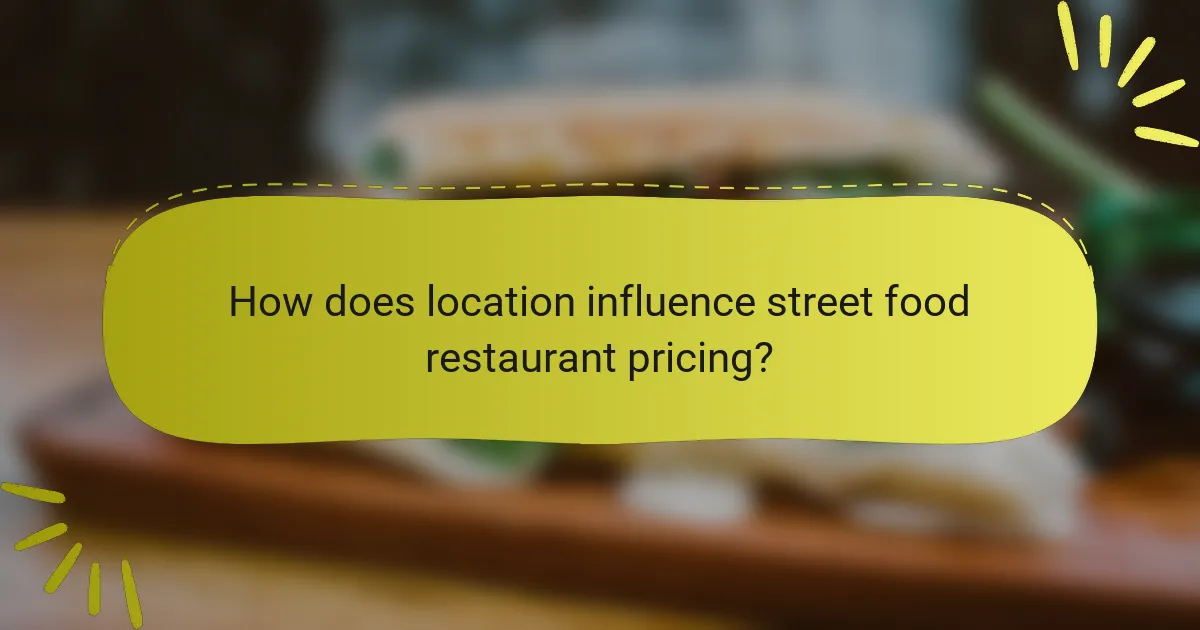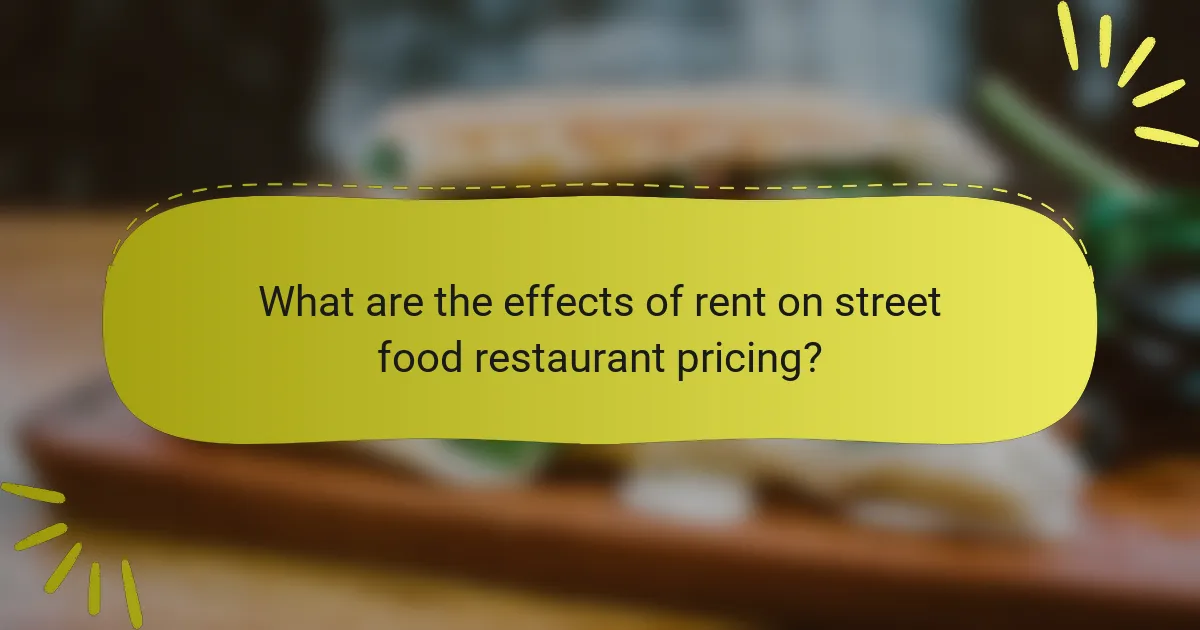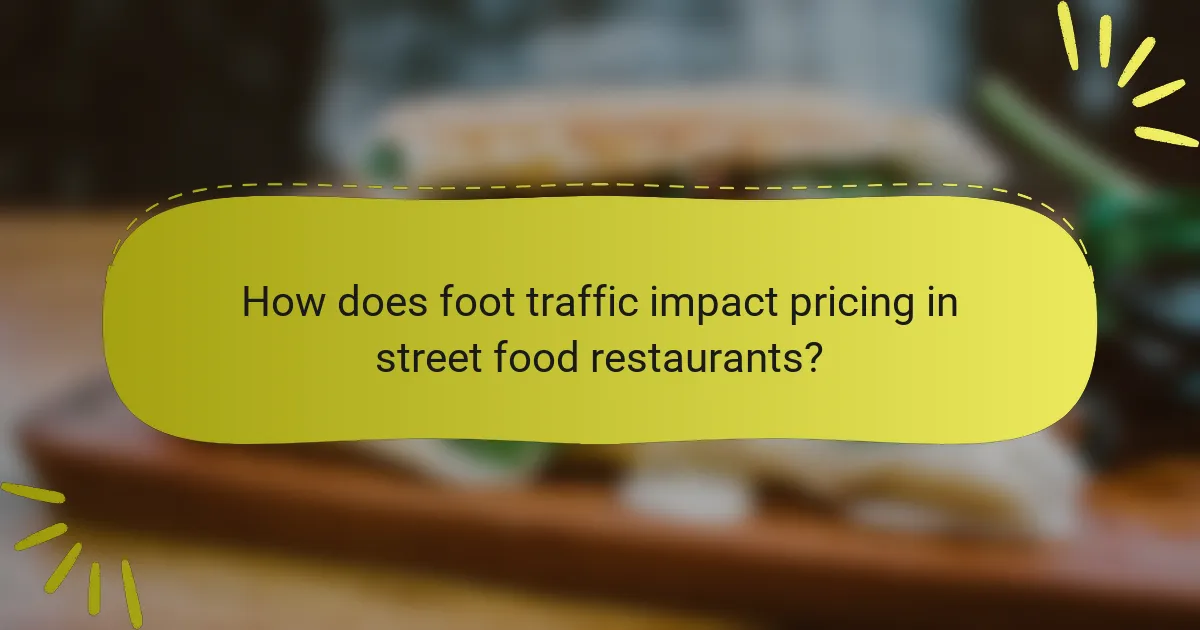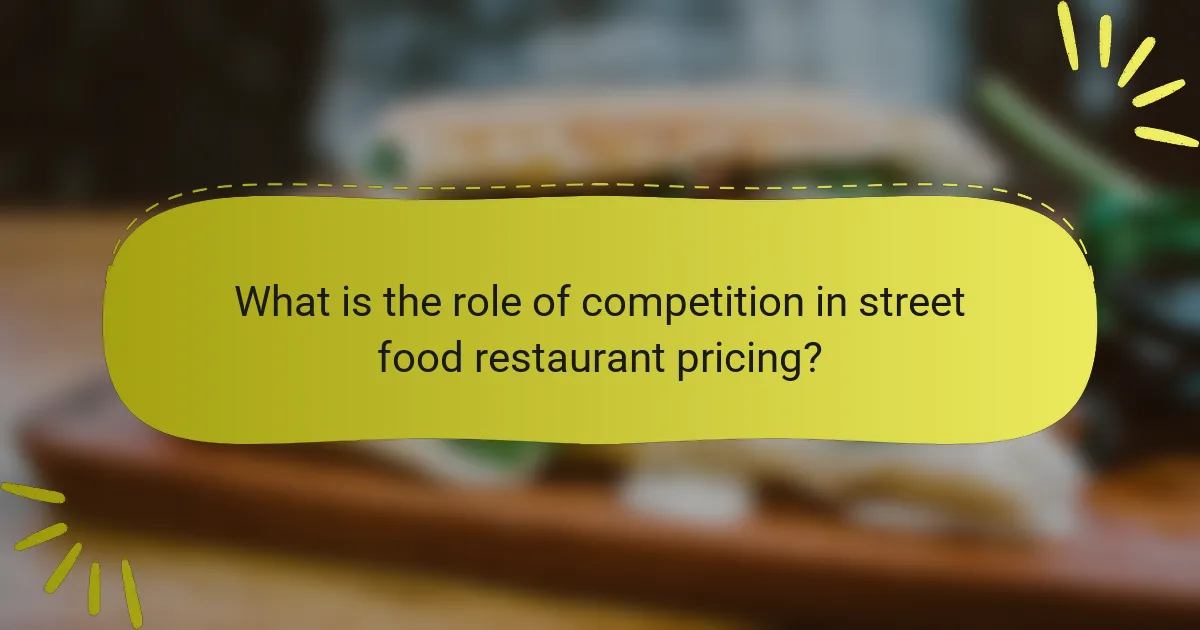The article examines how location influences pricing strategies in street food restaurants, focusing on three key factors: rent, foot traffic, and competition. It highlights that higher rent in prime areas leads to increased menu prices, as vendors must cover operational costs. The analysis shows that greater foot traffic allows restaurants to charge more due to higher demand, while competition among vendors can result in price adjustments, either lowering prices in crowded areas or allowing for premium pricing in unique locations. Additionally, the article discusses how local economic factors, such as income levels, further affect pricing decisions for street food vendors.

How does location influence street food restaurant pricing?
Location significantly influences street food restaurant pricing. Higher rent in prime areas leads to increased menu prices. Restaurants in busy districts can charge more due to greater foot traffic. Increased visibility attracts more customers, allowing for higher pricing. Competition also plays a role; areas with many vendors may drive prices down. Conversely, unique locations with less competition can allow for premium pricing. Economic factors, like local income levels, affect what customers are willing to pay. Thus, location directly impacts operational costs and pricing strategies for street food vendors.
What are the key factors that determine pricing in street food restaurants?
Key factors that determine pricing in street food restaurants include location, ingredient costs, and competition. Location affects rent and foot traffic, influencing pricing strategies. High foot traffic areas often allow for higher prices due to increased customer volume. Ingredient costs directly impact menu pricing; fresher or specialty ingredients typically raise prices. Competition in the area also dictates pricing; restaurants may need to adjust prices to remain competitive. Additionally, target market demographics can influence pricing decisions as well.
How does rent impact the overall pricing strategy?
Rent significantly impacts the overall pricing strategy of a street food restaurant. High rent costs often force restaurants to increase menu prices to maintain profitability. Conversely, lower rent can allow for competitive pricing, attracting more customers. For example, a street food vendor in a high-rent area may charge $10 for a dish, while a vendor in a lower-rent area might charge $7. This difference reflects the need to cover fixed costs associated with rent. Ultimately, rent influences pricing decisions by dictating how much revenue must be generated to sustain operations.
What role does foot traffic play in setting prices?
Foot traffic significantly influences pricing strategies for street food restaurants. Higher foot traffic indicates greater customer potential, allowing businesses to set higher prices. Conversely, lower foot traffic may necessitate lower prices to attract customers. A study by the National Restaurant Association found that restaurants in high-traffic areas often charge 10-20% more than those in low-traffic locations. This pricing strategy is essential for maximizing revenue and covering higher rent costs associated with prime locations. Therefore, foot traffic directly correlates with pricing decisions in the street food sector.
How does competition affect pricing decisions?
Competition directly influences pricing decisions by forcing businesses to adjust their prices to remain attractive to consumers. When competitors lower their prices, a business may need to follow suit to retain customers. Conversely, if a competitor offers a unique product or service, a business may increase prices to reflect perceived value. Market dynamics indicate that intense competition typically leads to lower prices, as businesses strive to capture market share. According to a study by the National Bureau of Economic Research, price competition can result in prices being driven down to marginal cost levels in highly competitive markets. Therefore, competition plays a crucial role in shaping pricing strategies within the street food sector.
Why is understanding location crucial for street food restaurant success?
Understanding location is crucial for street food restaurant success because it directly influences customer accessibility and sales. A well-chosen location attracts higher foot traffic, which increases potential customers. Studies show that restaurants in busy areas see up to 50% more customers compared to those in less trafficked locations. Proximity to attractions, offices, and residential areas enhances visibility and convenience. Additionally, understanding local competition helps in positioning and pricing strategies. For instance, a street food vendor near a food market can leverage the existing customer base. Therefore, location significantly impacts revenue, brand recognition, and overall business viability.
What are the implications of high-rent areas on pricing?
High-rent areas directly increase pricing for street food restaurants. Elevated rent costs necessitate higher menu prices to maintain profitability. For instance, a study by the National Restaurant Association indicates that operational costs rise significantly in urban centers. Consequently, restaurants in these locations often charge 10-30% more compared to similar establishments in lower-rent areas. This pricing strategy also reflects the higher disposable income of customers in affluent neighborhoods. Additionally, competition in high-rent areas can further influence pricing dynamics. Restaurants may raise prices to differentiate themselves and cover higher costs associated with premium ingredients or unique offerings.
How can foot traffic be measured and analyzed?
Foot traffic can be measured and analyzed using various methods. Common techniques include manual counting, electronic sensors, and mobile tracking. Manual counting involves staff counting individuals entering or exiting a location. This method provides basic data but can be labor-intensive and prone to human error. Electronic sensors, such as infrared beams or video cameras, automatically track foot traffic. These devices can provide real-time data and are more accurate than manual counting. Mobile tracking uses smartphone data to analyze movement patterns. This method leverages GPS and location services to estimate foot traffic in specific areas.
Analyzing foot traffic data involves examining trends over time. Businesses can identify peak hours and days by comparing data across different periods. This analysis helps in making informed decisions regarding staffing and inventory. Additionally, correlating foot traffic with sales data can reveal the impact of pedestrian activity on revenue. Studies show that higher foot traffic often leads to increased sales for retail and food establishments. For example, a report by the International Council of Shopping Centers indicates that a 10% increase in foot traffic can lead to a 5% increase in sales.

What are the effects of rent on street food restaurant pricing?
Rent significantly affects street food restaurant pricing. Higher rent costs lead to increased menu prices. This is because landlords often charge more in high-traffic areas. Street food vendors must cover these expenses to maintain profitability. For example, a study by the National Restaurant Association found that rent constitutes about 10-15% of total operating costs. If rent increases, vendors may raise prices to offset losses. Consequently, consumers may pay more for street food in prime locations.
How does rent vary across different locations?
Rent varies significantly across different locations due to factors like demand, local economy, and amenities. Urban areas typically have higher rent due to increased demand and foot traffic. For example, a street food restaurant in a busy city center may pay up to 50% more in rent compared to one in a suburban area. Additionally, locations near popular attractions or high-density residential areas command premium rents. In contrast, rural or less populated areas often have lower rent prices due to reduced demand. According to the National Association of Realtors, urban commercial rents have risen by an average of 3.5% annually over the past five years, reflecting these dynamics.
What are the typical rent ranges for street food vendors in urban areas?
Typical rent ranges for street food vendors in urban areas vary significantly. They can range from $500 to $3,000 per month. Factors influencing rent include location, foot traffic, and local regulations. Prime urban locations with high foot traffic command higher rents. In contrast, less busy areas may see lower rent prices. Research indicates that vendors in high-demand districts often pay premium rates. For example, a study by the Street Vendor Project found that rents in busy areas can exceed $2,500 monthly. This data reflects the competitive nature of urban street food markets.
How do lease agreements influence pricing strategies?
Lease agreements significantly influence pricing strategies for street food restaurants. The terms of a lease dictate the fixed costs associated with operating in a specific location. Higher rent can lead to increased menu prices to maintain profit margins. Conversely, lower rent allows for more competitive pricing. Lease duration also impacts pricing; longer leases may encourage investment in quality, while short-term leases may prioritize quick returns. Additionally, lease agreements can affect the flexibility of pricing strategies, limiting adjustments based on market conditions. Research indicates that locations with high foot traffic often command higher rents, further influencing pricing strategies to align with customer expectations and competition.
What strategies can street food restaurants employ to manage rent costs?
Street food restaurants can manage rent costs by negotiating lease terms, opting for pop-up locations, and sharing spaces with other vendors. Negotiating lease terms may involve seeking lower rates or longer lease durations for stability. Pop-up locations allow restaurants to operate temporarily without long-term commitments, reducing financial risk. Sharing spaces with other vendors can lower overhead costs by splitting rent and utilities. These strategies help street food restaurants maintain profitability in competitive markets.
How can vendors negotiate better lease terms?
Vendors can negotiate better lease terms by conducting thorough market research on rental rates in their area. Understanding local market trends allows vendors to identify fair pricing and leverage this information during negotiations. Vendors should also assess the foot traffic and competition in the location, as these factors influence the lease’s value. Building a strong relationship with the landlord can create a more favorable negotiation environment. Additionally, vendors can consider offering longer lease terms in exchange for lower monthly rates. Presenting a solid business plan can demonstrate financial stability, making landlords more willing to negotiate. Finally, being prepared to walk away from unfavorable terms can strengthen a vendor’s negotiation position.
What alternative locations can help reduce rent expenses?
Suburban areas can help reduce rent expenses for street food restaurants. These locations typically offer lower rental rates compared to urban centers. Areas with less foot traffic may also have reduced competition, which can lower costs. Additionally, emerging neighborhoods often have affordable rent as they are still developing. Locations near public transportation can attract customers without high rent costs. Research indicates that suburban locations can have rent savings of 20-50% compared to downtown areas. This makes them an attractive option for new or budget-conscious street food businesses.

How does foot traffic impact pricing in street food restaurants?
Foot traffic significantly impacts pricing in street food restaurants. Higher foot traffic often leads to increased demand for food items. This demand allows restaurants to charge higher prices. Conversely, low foot traffic may force restaurants to lower prices to attract customers. Research indicates that locations with high pedestrian activity can see price increases of 10-20%. This correlation is due to the perceived value of convenience and accessibility. Additionally, competition in high foot traffic areas can influence pricing strategies. Overall, foot traffic is a critical factor in determining the pricing structure of street food offerings.
What metrics are used to assess foot traffic levels?
Metrics used to assess foot traffic levels include visitor counts, dwell time, and conversion rates. Visitor counts measure the number of individuals entering a specific area. Dwell time indicates how long people stay in that area. Conversion rates reflect how many visitors make a purchase or engage with a business. Additional metrics may include peak hours, demographic information, and traffic patterns. These metrics provide insights into customer behavior and help businesses optimize their strategies. Accurate foot traffic data can lead to improved marketing and pricing decisions.
How can street food vendors increase visibility to attract more customers?
Street food vendors can increase visibility by utilizing eye-catching signage and strategic location placement. Bright, clear signs attract attention from passersby. Vendors should position their stalls in high foot traffic areas to maximize exposure. Engaging with customers through social media can also enhance visibility. Platforms like Instagram and Facebook allow vendors to showcase their offerings. Offering samples or promotions can draw in potential customers. Collaborating with local events or festivals can further increase visibility. These strategies are effective in attracting more customers and enhancing overall sales.
What time of day sees the highest foot traffic for street food?
Evening hours, particularly from 6 PM to 9 PM, see the highest foot traffic for street food. This peak time coincides with people finishing work and seeking dinner options. Many individuals prefer street food for its convenience and affordability during this period. Studies indicate that outdoor markets and food stalls experience increased patronage in the evening. Events, nightlife, and social gatherings also contribute to this trend. Consequently, street food vendors often adjust their hours to maximize sales during these busy times.
How can street food restaurants leverage foot traffic for pricing?
Street food restaurants can leverage foot traffic for pricing by adjusting menu prices based on customer volume. High foot traffic areas enable restaurants to set competitive prices due to increased demand. For instance, during peak hours, they can implement dynamic pricing strategies, raising prices slightly to maximize profits. Conversely, during slower periods, they can offer discounts to attract more customers.
Research indicates that restaurants in high-traffic zones can increase their prices by 10-20% compared to those in lower-traffic areas without losing customers. This strategy is effective because it capitalizes on the convenience factor for customers in busy locations. Additionally, offering limited-time specials can create urgency, encouraging immediate purchases. Overall, understanding foot traffic patterns allows street food restaurants to optimize pricing effectively.
What pricing strategies work best during peak foot traffic hours?
Dynamic pricing and promotional discounts are effective pricing strategies during peak foot traffic hours. Dynamic pricing adjusts prices based on demand and traffic levels, maximizing revenue. For example, prices may increase during lunch rush hours when foot traffic peaks. Promotional discounts attract more customers, encouraging higher sales volume. Offering limited-time deals can create urgency, prompting quick purchasing decisions. According to research by the National Restaurant Association, 67% of consumers are influenced by discounts during peak times. These strategies optimize sales and enhance customer engagement during high-traffic periods.
How can vendors adjust their offerings based on foot traffic analysis?
Vendors can adjust their offerings based on foot traffic analysis by identifying peak times and customer preferences. Analyzing foot traffic data reveals when the highest number of potential customers are present. This information allows vendors to optimize menu items for those times. For example, a vendor may introduce quick-service items during busy lunch hours.
Additionally, understanding customer demographics from foot traffic patterns can guide vendors in tailoring their offerings. If data shows a high number of families, vendors may add kid-friendly options. Conversely, if young adults dominate the traffic, trendy or gourmet items could attract more sales.
Implementing these changes can lead to increased customer satisfaction and higher sales. A study by the National Restaurant Association found that 60% of diners prefer restaurants that adapt their menus to local tastes. This proves that aligning offerings with foot traffic insights can significantly enhance a vendor’s success.

What is the role of competition in street food restaurant pricing?
Competition significantly influences street food restaurant pricing. When multiple vendors operate in the same area, they often adjust their prices based on competitors. This can lead to price wars, where restaurants lower prices to attract customers. Conversely, if a vendor offers unique products or superior quality, they may maintain higher prices.
Market research shows that locations with high competition often see lower average prices. A study by the National Restaurant Association found that 70% of street food vendors adjust their prices based on nearby competitors. Thus, competition drives pricing strategies and impacts overall profitability in the street food market.
How can competition influence pricing strategies?
Competition can significantly influence pricing strategies by forcing businesses to adjust their prices to remain competitive. When multiple street food vendors operate in close proximity, they often engage in price competition. This competition can lead to lower prices as vendors attempt to attract more customers. According to a study by the National Restaurant Association, 70% of consumers consider price when choosing where to eat. Additionally, if one vendor lowers prices, others may follow suit to avoid losing customers. This dynamic can create a pricing war, ultimately benefiting consumers through lower prices. Conversely, in areas with less competition, vendors may set higher prices without fear of losing customers. Thus, competition directly impacts how street food restaurants price their offerings.
What competitive analysis methods can street food vendors use?
Street food vendors can use several competitive analysis methods. They can conduct market research to understand customer preferences and trends. Observing competitors’ pricing strategies helps vendors adjust their own prices effectively. Analyzing foot traffic patterns provides insight into peak times and customer demographics. Utilizing social media monitoring allows vendors to gauge customer feedback and competitor promotions. Surveys can also be employed to gather direct insights from potential customers. Additionally, studying location-based competition helps vendors identify areas with less saturation. These methods collectively enable street food vendors to make informed business decisions and enhance their market position.
How does market saturation affect pricing decisions?
Market saturation leads to increased competition among businesses. This competition often forces prices down as companies strive to attract customers. In saturated markets, consumers have more choices, which intensifies price sensitivity. Businesses may respond by lowering prices to maintain or grow their market share. Additionally, saturated markets can lead to price wars, further driving prices down. According to a study by the Harvard Business Review, companies in saturated markets often experience reduced profit margins. Therefore, market saturation significantly influences pricing strategies across industries.
What are effective strategies for competing in a crowded market?
Effective strategies for competing in a crowded market include differentiation and targeted marketing. Differentiation involves offering unique products or services that stand out from competitors. This could mean using local ingredients or innovative recipes in street food offerings. Targeted marketing focuses on specific customer segments to tailor messaging and promotions effectively.
Additionally, leveraging social media can help build brand awareness and engage with customers directly. Establishing partnerships with local businesses can also enhance visibility and attract more foot traffic. According to a study by the Small Business Administration, businesses that differentiate themselves can increase their market share significantly.
How can unique offerings differentiate a street food restaurant?
Unique offerings can differentiate a street food restaurant by providing distinctive flavors or dishes not available elsewhere. These unique offerings attract customers seeking new culinary experiences. For example, a restaurant that specializes in fusion cuisine may draw attention in a competitive area. Additionally, limited-time offers or seasonal specialties can create urgency and increase foot traffic. Unique dietary options, such as vegan or gluten-free dishes, can appeal to specific customer segments. According to a study by the National Restaurant Association, 40% of consumers are interested in trying new flavors and cuisines. This interest highlights the potential for unique offerings to enhance a restaurant’s marketability and customer base.
What role does customer loyalty play in pricing adjustments?
Customer loyalty significantly influences pricing adjustments for businesses. Loyal customers are often willing to pay higher prices for products or services they trust. This willingness allows businesses to implement price increases without losing their customer base. Moreover, loyal customers tend to make repeat purchases, providing a stable revenue stream. Research shows that retaining existing customers is cheaper than acquiring new ones, which supports the justification for higher prices. Additionally, businesses may offer loyalty programs that reward repeat customers, enhancing perceived value and justifying pricing strategies. Overall, customer loyalty enables more flexible pricing adjustments that can enhance profitability.
What practical tips can street food vendors use to optimize pricing based on location?
Street food vendors can optimize pricing based on location by analyzing local demographics and purchasing power. Understanding the income levels of the target market helps set competitive prices. Vendors should also consider foot traffic patterns. High foot traffic areas can justify higher prices due to increased customer volume.
Monitoring competitors in the area is crucial. Adjusting prices based on competitor offerings can maintain competitiveness. Seasonal events or local festivals can also influence pricing strategies. Vendors should increase prices during such events to capitalize on higher demand.
Finally, gathering customer feedback on pricing can provide insights. This feedback can guide adjustments to better meet customer expectations and willingness to pay.
How can vendors balance quality and pricing effectively?
Vendors can balance quality and pricing effectively by implementing cost control measures while maintaining product standards. They can source high-quality ingredients at competitive prices through strategic supplier relationships. Offering a limited menu can reduce waste and streamline operations, which lowers costs. Additionally, vendors can use customer feedback to adjust offerings, ensuring that quality meets market expectations without overspending. Research shows that vendors who focus on operational efficiency can maintain quality while keeping prices attractive. For instance, a study by the National Restaurant Association found that optimizing supply chains can lead to a 10-15% reduction in costs, allowing for better pricing strategies.
What tools are available for analyzing local market conditions?
Market analysis tools include Geographic Information Systems (GIS), market research software, and data analytics platforms. GIS tools help visualize and analyze spatial data related to demographics and competition. Market research software, like SurveyMonkey and Qualtrics, gathers consumer insights and preferences. Data analytics platforms, such as Tableau and Google Analytics, analyze trends and patterns from various data sources. These tools provide valuable insights into local market conditions, helping businesses make informed decisions. For example, GIS can reveal areas with high foot traffic, crucial for street food restaurant placement.
The main entity of this article is street food restaurant pricing, which is significantly influenced by location. Key factors affecting pricing include rent, foot traffic, and competition. Higher rent in prime areas often leads to increased menu prices, while busy districts can charge more due to greater customer volume. Additionally, the level of competition in an area can drive prices down or allow for premium pricing based on unique offerings. This article analyzes how these elements interact to shape pricing strategies for street food vendors, providing insights into effective management practices.